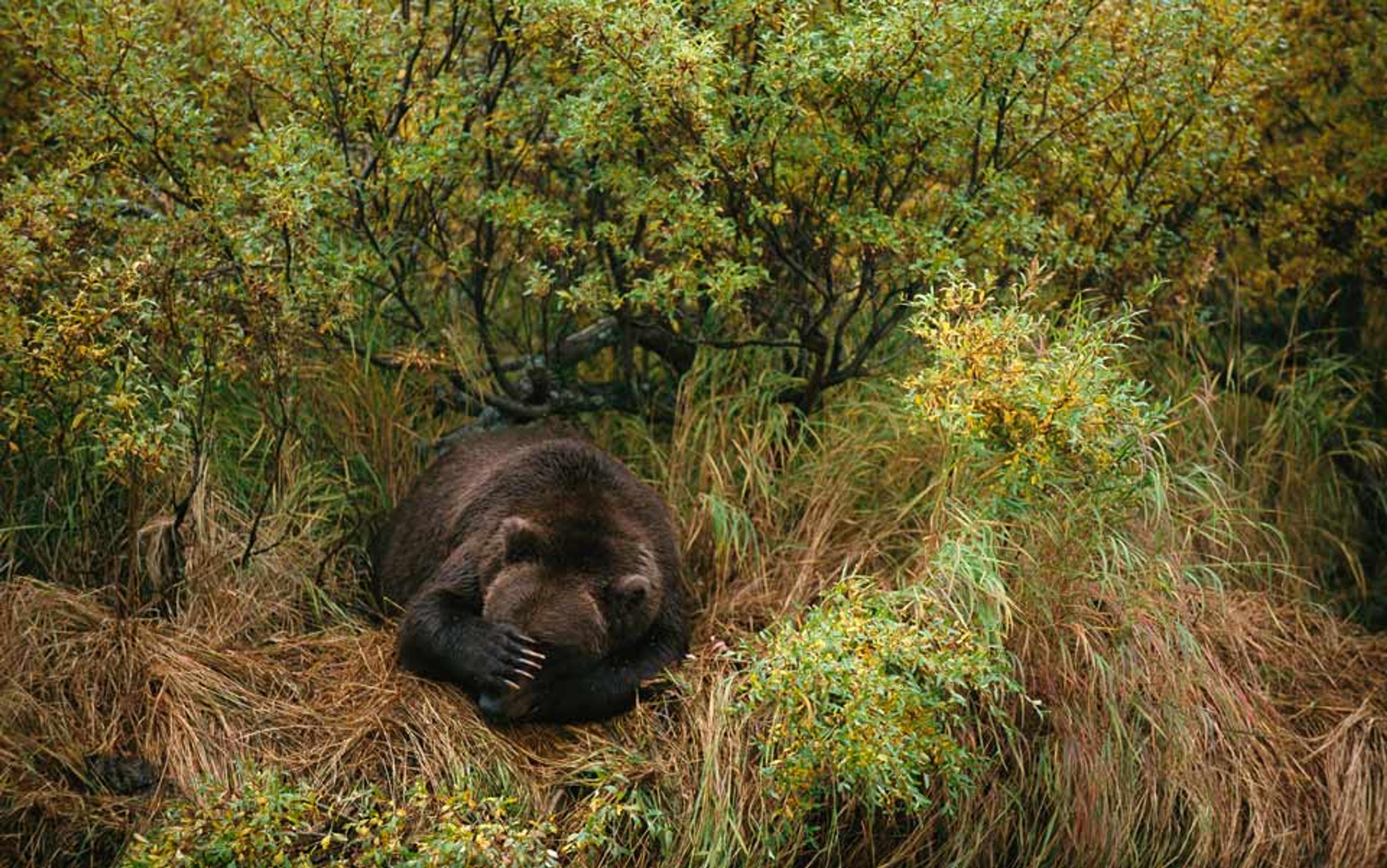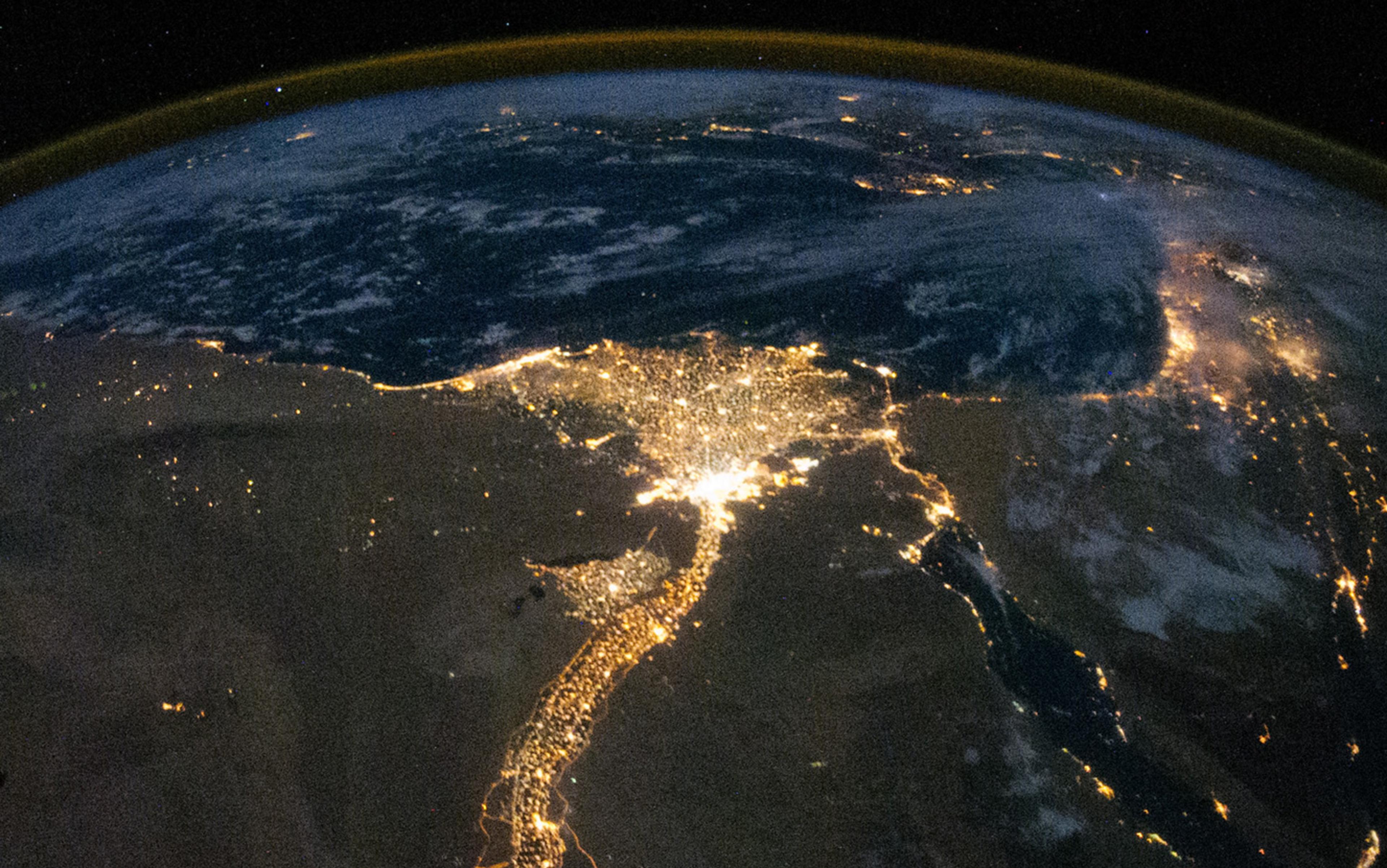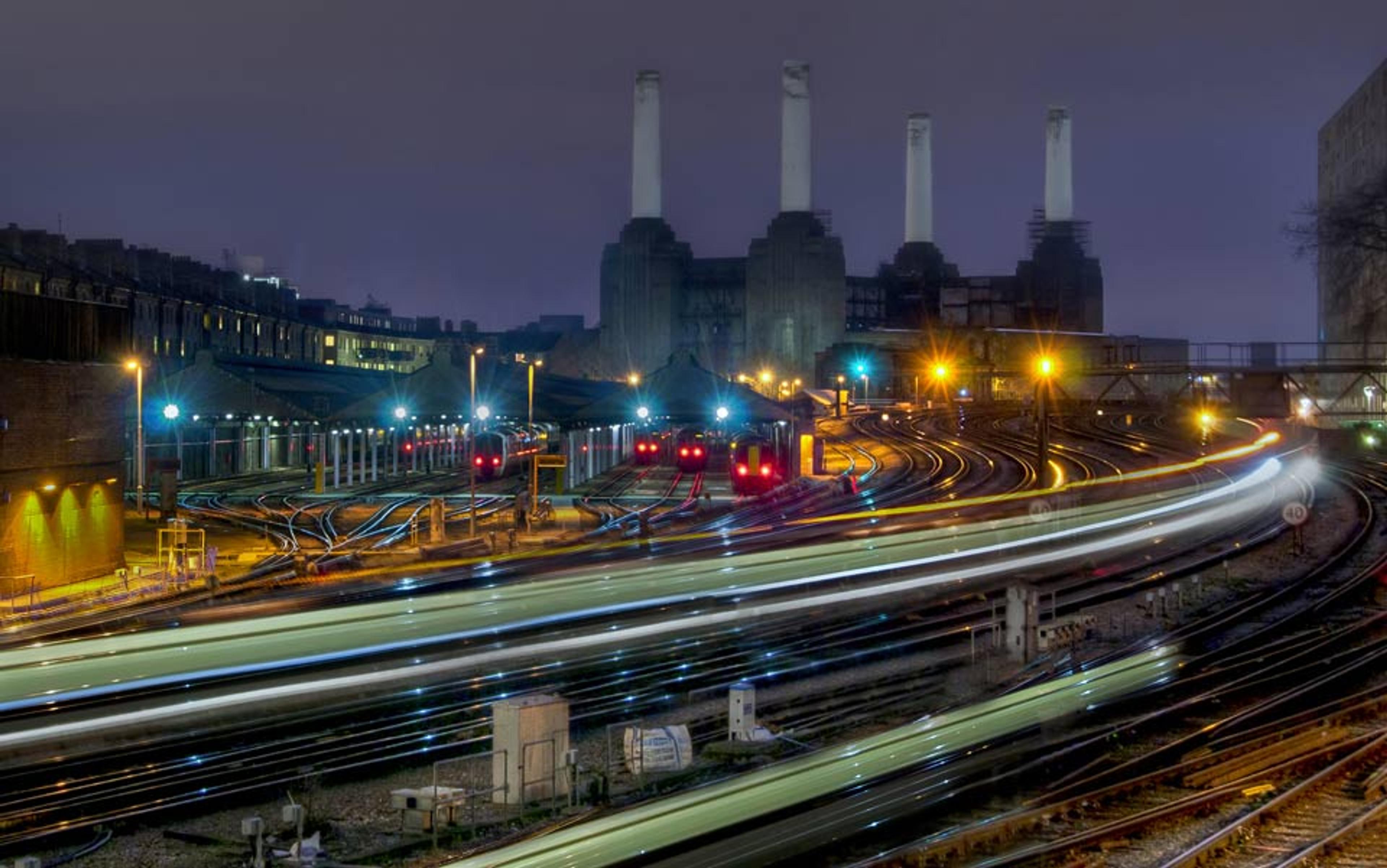A sword of Damocles of sorts has hung over the Swanscombe Marshes in Kent for so many years that its long shadow is starting to weaken. The threat takes the form of a prospective theme park, thrillingly called ‘The London Resort’ and described as England’s answer to Disneyland. Until now, the realisation of the plan and all its accoutrements, lavatories, carparks, access roads and whatnot, has been kept at bay by determined environmentalists and protracted legalities. More: a species of arachnid, the distinguished jumping spider, has, by dint of its scarcity and its fondness for Swanscombe, proved a powerful weapon for those who would do without theme parks. Not for them the ‘globally competitive … step-change in leisure and entertainment provision’ that the London Resort promises, along with the siren call of job creation.

The Distinguished Jumping spider (Attulus distinguendus). Photo ©P.R. Harvey/Spider Recording Scheme/British Arachnological Society (2022)
A pen portrait of the Swanscombe Marshes: they lie on a spur of land, protruding from the semi-industrial, southern bank of the Thames. Though hemmed in by a cement works, refineries, housing developments and retail outlets, they feel quite expansive. Here, the Thames has escaped the ceremonial and sclerotic trappings that pinch it from Greenwich to St Paul’s Cathedral. It is broader, brinier and brawnier. The marshes are part of a small semi-wilderness that includes brambles, catkin-laden willows (in March), blossom-burdened fruit trees, reedy waterways, and grasslands, all caught in the crook of the peninsula. There are interesting contours like those of a ruched rug. And rough, unkempt textures; marsh and gravel, paths and patterns.
The place twitches with little mysteries. In a small creek at the river’s edge, boat-dwellers lead secret lives aboard barges and houseboats, affixed to the shore by rickety walkways. In from the shore, obscure structures – huts, towers, rusting iron assemblages – rise out of the earth, their purposes long forgotten and obsolete. There are few people – jogging or walking dogs. But many birds. An egret flaps out of the reeds like a lazily thrown pillowcase. Goldfinches chatter against the whine and growl of the cement works. Depending on the time of year, the marshes are a home for redstarts and cuckoos, nightingales and nightjars – and the distinguished jumping spider (which might prove their saviour). To my mind, Swanscombe is an exemplary urban wetland. But it’s not the only one.
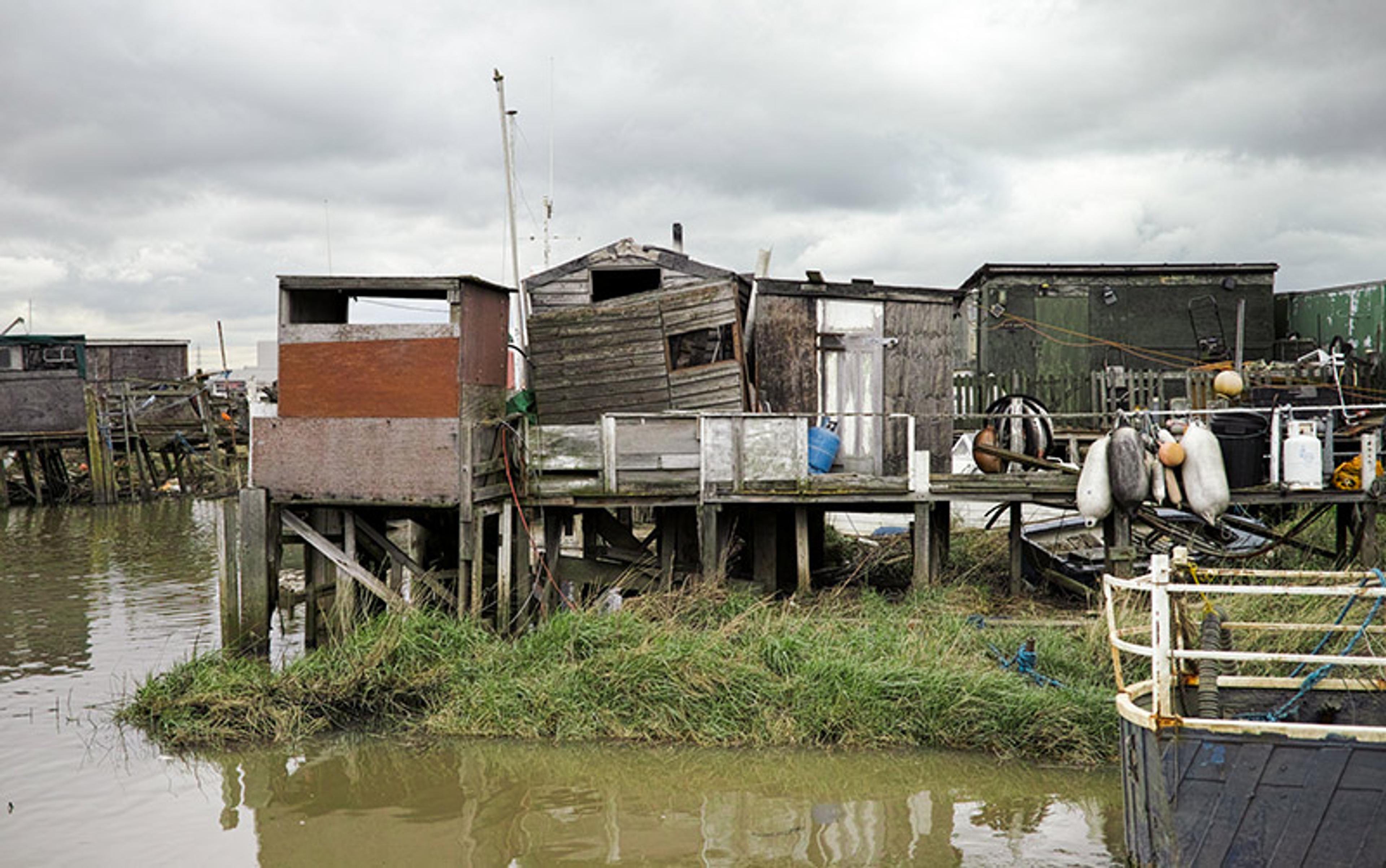
Structures on Broadness Creek in Swanscombe in 2014. Photo by Anthony Palmer.
In centuries, even decades past, out-of-the-way marshlands were regarded as little more than terra nullius, where the writ of law scarcely ran, but disease did, rampantly, with other threats to civilised life: sun-shunning shadows and familiars, footpads and free-traders, lost and wondering/wandering souls, both of this world, and another.
The genealogist William Dugdale once asked in relation to unreclaimed swamps and marshes:
What expectation of health can there be to the bodies of men, where there is no element good? The Air being for the most part cloudy, gross, and full of rotten harrs; the Water putrid and muddy, yea full of loathsome vermin; the Earth spungy and boggy; and the Fire noisome by the stink of smoaky hassocks?
Few, in 1662, when Dugdale was writing, would have challenged the obvious truths he stated. But perhaps we’re bigger than that now. We have medicine to fight the ague, and enough psychoanalytic theory drip-fed into the zeitgeist that, not only are we more at ease with our shadows, we’re less afraid of the wilder places in which they themselves are at ease.
And perhaps our cities, too, are ready to embrace the elements out of which they emerged. Where once a London or a Paris might boast ‘what you see now was once mud, marsh or swamp’, an enlightened city might now nod deferentially to its origins, savouring the richness they’ve bestowed.
It would be a shame, though, if these damp outlands were to wholly slough their more roguish, raffish reputations. Unkempt, only haphazardly sculpted, beguiling and wistful and lacking conventional geometry, wetlands, sub-, intra- and extra-urban, fit that bill quite deliciously. The smallest area of marsh or similar can be immensely rich by virtue of its birds, reptiles, amphibians and insects, and in baffling the clamorous fruits of civilisation, can bring us closer to ourselves.
For those who care, global statistics are dismal. The UK-based Wildfowl and Wetlands Trust (WWT) claims that wetlands are being destroyed at a rate ‘three times faster’ than that of forest areas; and, since the early 1700s, 87 per cent of the world’s wetlands have been lost to development. American wetlands, as the writer Annie Proulx lamented in a recent essay published in The New Yorker, have borne the brunt of much of the destruction. By the 1980s, ‘roughly half … had been wiped out,’ she said. ‘In 1990 the US Fish and Wildlife Service published a study showing that since the 1600s the country’s treasury of wetlands had shrivelled to 103 million acres, and that some states had lost almost all their original wetlands.’ Much of what remains is threatened by pollution. The thread that saves Swanscombe for the moment may yet break. But there’s hope – not only for Swanscombe, but more broadly, for bogs, marshes, swamps and fens – from a growing recognition of the economically quantifiable benefits they bring, among them flood mitigation, infrastructure protection, leisure, fisheries and protection of genetic diversity. (A 2004 report published by the World Wide Fund for Nature estimated that the global annual value could be as high as $70 billion; in reality, it’s a figure that’s difficult to quantify, but nonetheless the benefits are priceless.)
The city – not just London, Paris, St Petersburg, etc, but ‘the city’ as an idea – needs wetlands for its own mental and physical sanity (more than it does theme parks). For, from the swamp, so many great metropolises have arisen and, while to say that to it they shall return resounds with Old Testament gloom, as cities age they need to give due respect to their origins. It may possibly be dangerous not to: the academic and writer Rod Giblett describes wetlands as being ‘repressed’ by city development, and has even coined the term ‘aquaterrapolis’ to describe cities (New York, Hamburg, London, Berlin, etc) built at the expense of marshes – with an incalculable environmental loss attendant on each. But, he says, what is repressed will only manifest itself in troubles down the line, whether flooding or subsidence, or problems yet to be discovered.
The Ramsar Convention (named for the Iranian city in which the intergovernmental agreement was hammered out) defines wetlands as: ‘areas of marsh, fen, peatland or water, whether natural or artificial, permanent or temporary, with water that is static or flowing, fresh, brackish or salt, including areas of marine water the depth of which at low tide does not exceed six metres.’
Some might argue that there should never have been a city where New Orleans now stands
In practice, wetlands defy easy categorisation. Some resemble sunken forests; others sodden fields. There are no thresholds of size. A wetland can be as vast as the Sudd of Sudan, or a mere pocket of reedbed behind an industrial estate. In the London borough of Waltham Forest, the local council is encouraging the creation of ‘rain gardens’, little slithers of greenery, which look like mere flowerbeds or part of a city-prettification project but are engineered as sustainable drainage systems, better known as SuDS. These attempt to replicate the behaviour of natural drainage systems, instead of immediately directing water to watercourses, using pipes or sewers. In their own way, they’re an epitome of wetland engineering. Clever, discreet, improving, aesthetic – and environmentally purposeful. Though tiny, in sufficient number SuDS can contribute, say their proponents, to city flood defences and the promotion of biodiversity.
A wetland can be entirely natural, or moulded by human needs or desires. But what makes them ‘urban’, specifically? Many wetlands, like Swanscombe and the plethora of London marshes, but also the Hackensack Meadowlands skirting New York, sit at the city’s fringes as remnants of their once more substantial former selves, devoured by desiccation and development. But then Venice, say, sitting in the middle of the lagoon that bears its name, is a city in a wetland, reversing the usual formula, while Amiens, in northern France, is bounded by a patchwork of hortillons, artificial island meadows on which the town’s inhabitants have tended crops of excellent carrots, leeks and onions for centuries.
New Orleans was built on a swamp, its first houses assembled from the cypress trees which grew in it. Like so many cities, it has ‘battled’ for centuries with the consequences of employing simplistic ‘solutions’ to mitigate flooding caused by the loss of wetlands that act as natural sponges for excess water. Some might argue that there should never have been a city where New Orleans now stands (though no one who has been there could, with any great conviction).
Consider also, the Sungei Buloh Wetland Reserve – a rare acreage of mangrove in the northwest of Singapore, overlooked by the intimidatingly high-rise city of Johor Bahru, on the Malaysian side of the straits. The reserve boasts bird hides, a café, a ‘wireless learning trail’ and corporate sponsorship, and the experience, though intended to give a sense of the wild, is correspondingly tame, more akin to an ‘infotainment’ offering than to nature. But that doesn’t deter the twitchers who come to visit, or the milky storks, whimbrels, greenshanks, redshanks, egrets and eagles, terns and bitterns, or the resident brahminy kites that overlord the whole, with an eye for the mudskippers, skipping in the mud.
Generations past, the notion of visiting a swamp as a weekend activity might have been regarded as bizarre, perverse or dangerous. But, in step with an age busy rethinking so many long-held conventions about our responsibility toward nature, a cavalry of NGOs, academics, environmentalists (global, local and ‘glocal’), even governments looking for fixes for urban ills is coming to the rescue, rehabilitating the reputation of wetlands as sinister and uncouth.
Arguably, it was Dugdale, sworn enemy of ‘smoaky hassocks’ and ‘rotten harrs’, who set the tone in The History of Imbanking and Drayning of Divers Fenns and Marshes, Both in Forein Parts and in This Kingdom (1662), in which he poured praise upon the city’s fathers and mothers (Babylonian, Greek, Egyptian and many more), who, in ancient times, were propelled by the laudable impulse to ‘imbank’, ‘drayn’ and generally desiccate wetlands. This, he pointed out, resulted in larger areas of cultivatable land and grazing, improved transport links and lessened disease. Dugdale believed undrained lands were unpredictable and dangerous.
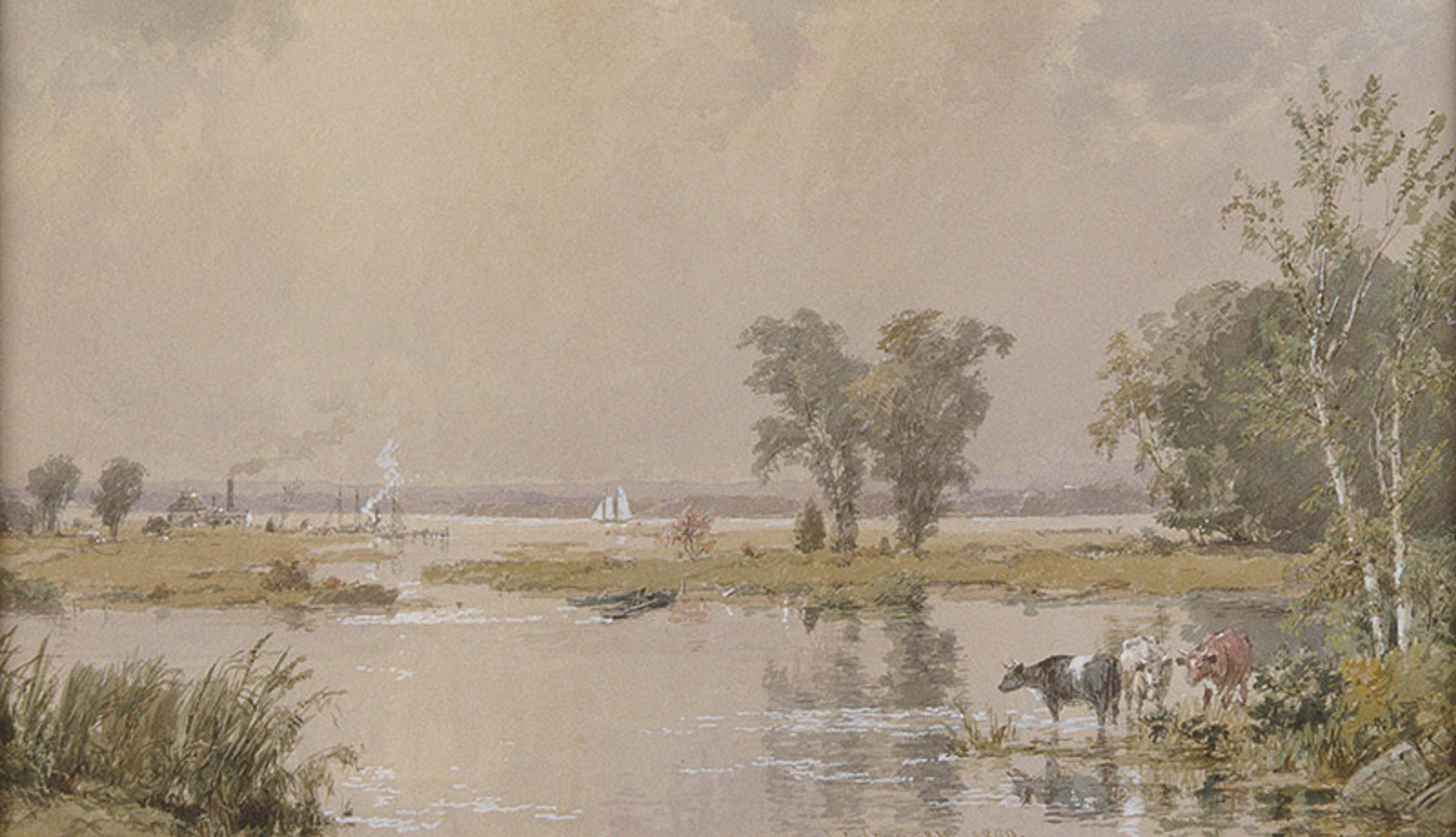
Hackensack Meadows (1890) by Jasper Francis Cropsey. Courtesy the Met Museum, New York
He was not alone. In 1867, a journalist writing about the Hackensack Meadowlands on the New Jersey-New York border perpetuated the same prejudice, writing:
Swamp-lands are blurs upon the fair face of Nature; they are fever-breeding places; scourges of humanity; which, instead of yielding the fruits of the earth and adding wealth to the general community, only supply the neighbouring places poisonous exhalations and torturing mosquitos. They are, for all practical purposes, worthless; and the imperative necessity for their reclamation is obvious to all, and is universally conceded.
The birds have returned, and criminal dumpers have been usurped by bird watchers and stressed-out New Yorkers
It is testimony to their resilience that the Hackensack Meadowlands didn’t vanish in a puff of spleen. Indeed, if you’ve ever had a window seat, flying in or out of JFK or Newark airports, you’ll have likely seen them, on the New Jersey side of the state line. Despite the surrounding industrial buildings, they glint enticingly when the weather permits.
For Indigenous peoples – and for early European settlers in America – what would become ‘the meadowlands’ served as a larder of fish, game and molluscs, and, later, for salt hay, scythed in the winter, when the marsh was frozen and could bear the weight of horse-drawn sleighs. As New York lost its reliance on equine resources, the marsh lost its utility and thence its value, though both were clawed back (tortuously) through grandiose and expensive land-filling and land-making schemes, which involved making high ground from low waste.
In the late 1950s, a boom industry of illegal fly-tipping took off, after the cash-strapped city ceased funding rubbish collection for commercial entities. This, the urban scholar Stephen Marshall described as resulting in ‘the Tony Soprano version of “the tragedy of the commons”’ – a theme also echoed in the film Gomorrah (2008), about mafia gangs in Naples illegally offloading toxic waste) – with ‘dozens of dumpers … making a continuous round of trips’ to deposit industrial waste. It was, figuratively, a tipping point, insomuch as that, by the late 1960s, legislation was put in place for the protection and restoration of the Meadowlands. Since then, the water has become cleaner, the birds have returned, and criminal dumpers have been usurped by bird watchers, school parties and stressed-out New Yorkers seeking a break from everything their city throws at them.
The impulse to restore – or even reproduce – wetlands is now global. In the United Kingdom, the WWT plans to restore 100,000 hectares (equivalent to three Isle of Wights) of wetlands in the next three decades. China has made great strides too. Pivotal to a flagship ‘new town’ project in Shandong province, for example, was that a landscape of degraded lake wetlands covering around 39 km2 should be restored in such a way that birdlife and fish would return, and that fringe benefits, such as improved water management, should be bestowed upon the urban environment. The project director told the magazine Metropolis, in 2016, that ‘[by] maintaining the existing wetland functions, improving entertainment and service facilities, and providing wetland science education and eco-tourism, we support the development of the city.’
Indeed, it is in China (home to 10 per cent of the world’s wetlands) that the notion of the ‘sponge city’ – like SuDS, but on a huge scale – is being pioneered. The ‘pillars’ on which it rests are meandering rivers, replete with vegetation to slow the flow of water, and a philosophy of leaving low-lying land undeveloped, acknowledging that concrete can never compete with flood and rising tides. But what China giveth with the one hand, it taketh away with another: a 2019 report on the ‘Hidden Loss of Wetlands in China’ found that, while China gained more than 27,600 km2 of wetland between 2000 and 2015, it lost almost as much to agriculture and urban development, especially in coastal areas. While the gains were welcome, the authors said, they did not offset the losses, especially to wildlife.
In cities where there is no actual wetland to restore, or little of it, there’s always the opportunity to start from scratch, repurposing brownfield sites such as industrial areas, or sewage works, to create bespoke ‘wetlands’ to address specific needs, such as water filtration, flood prevention – or indeed, the general promotion of mental and physical health. ‘Urban areas generally,’ the WWT’s head of policy and advocacy Tom Fewins told me, ‘are facing a number of crises. One of these is the climate crisis, that wetlands can mitigate by acting as a carbon sink.’ The particulars of this characteristic depend largely on the kind of wetland habitat being referred to but, for example, the anoxic (zero-oxygen) condition of some wetland soils slows decomposition and leads to the accumulation of organic matter.
Another front in the urban battle, Fewins points out, is the ‘wellbeing crisis, with record numbers of people reporting mental health issues, especially in the city. Wetlands can help with that too.’ Fewins talks about the ‘blue prescribing’ project, which saw participants spend a couple of hours each week for six weeks visiting a wetland centre, canoeing, walking or birdwatching, resulting, says the WWT, in ‘significant improvements in mental health across a range of indicators, including mental wellbeing, anxiety, stress and emotional wellbeing’. Perhaps this is only to restate the long-understood benefits of a pleasant walk in the countryside. But the WWT says (and I’d concur) that there’s something about where land and water meet that yields particular dividends for mental health.
As global temperatures and tower blocks continue to soar, there’s a suite of other, interlinked, considerations. It’s generally acknowledged that, as cities grow upwards and outwards, wetlands, even if some distance from the urban centre, are robbed, hydrologically speaking. And cities are growing. By 2050, the United Nations predicts, 68 per cent of the world’s population will live in urban areas. Concurrently, they’re getting hotter: as a paper for the NGO Wetlands International points out, they’re already suffering from the urban heat island effect, manifesting in higher temperatures in built up areas, ‘due to reduced green space, increased paved surfaces and more frequent heat waves stemming from climate change’.
The United States Environmental Protection Agency says that, on account of global warming, Chicago could, in the foreseeable future, see ‘30 more days per year rise above 100 degrees Fahrenheit’ if greenhouse gas emissions reach the highest predicted levels. City planners, it says, can help mitigate soaring temperatures with ‘green infrastructure’, ie by planting trees and other vegetation. Wetlands International makes the case for urban wetlands, which, it says, ‘help to cool cities and adapt to climate change’ and should be integrated into urban planning, arguing that we should be ‘investing in restoration (and in some cases construction of) urban wetlands for local climate action’.
The sky is huge and platinum white. Wedding parties gather on artificial islands beneath tapestried parasols
There’s more than sympathetic magic at play here. The argument runs that water has a higher specific heat capacity than the land, and this can help regulate the rate at which the air changes temperature – absorbing heat, before ultimately evaporating. Water also reflects solar radiation, whereas the built environment retains it.
Nowhere, perhaps, can such effects be more convincingly experienced than on the eastern edge of the city of Kolkata, where a complex of lakes and reservoirs – born from and part of the Hooghly-Bidyadhari river system, collectively known as the East Kolkata Wetlands (EKW) – presents a watery counterpoint to the dense bustle of humanity that is one of India’s most populous cities. The EKW represents a huge expanse that includes fishponds, paddy fields, vegetable gardens and grazing meadows. According to an NGO, the South Asian Forum for Environment (SAFE), now actively involved in its management, its yield is 150 tons of vegetables each day, 10,000 tons of ‘table-fish’ per year, and it sustains a livelihood for 100,000 people. On paper, the EKW is a veritable paragon of what an urban wetland can be.
.jpg?width=3840&quality=75&format=auto)
Photo by Tom Blass
The water at EKW is, indeed, cooling. The sky is huge and platinum white, turning to gold as the day grows old. Wedding parties gather on artificial islands beneath tapestried parasols and canopies, and sleek-hulled traditional fishing boats set out across the lakes, returning full-netted to the shore, where cats prowl, cows doze, and kohl-eyed children play. Inevitably, as per Swanscombe, there are joggers. But not so many as to be significantly disruptive. As also per Swanscombe, signs of the city – in particular, the skyline of the business district, though thinned by distance – dispel any notion that this is anything other than an urban wetland.
The origin of the EKW has many strands. Pre-existing marshland became a repository for garbage as the city grew, silting up the natural channels, but increasing fertility and productivity. In the 1940s, Calcutta, as it was then called, built new canals through the area in an effort to dispose of city sewage, and, in the decades following, enterprising local farmers took advantage, stocking ponds with fish and quickly developing intensive, and unique, aquaculture techniques – much of this expertise being retained informally. The EKW not only treats the sewage of one of the largest urban areas in one of the world’s most populous countries, it also provides protein and vegetables, cools the city, and offers a picturesque setting for family occasions. By dint of its biomass (especially phytoplankton), it is an important carbon sink. And it is eminently joggable.
The rub comes in the form of the inevitable strains that a city the size of Kolkata (population 15 million) is going to generate. Already, half of the EKW’s original footprint has been sacrificed to a rather dull, but probably necessary, suburb called Salt Lake City, or Bidhannagar. And the municipal authority is building a nearby satellite city, New Town, already teeming with mid-rise apartment blocks competing for water with the EKW. Industrial projects, planned expressways and garbage dumping (pace the Hackensack Meadowlands) all threaten further incursion. There is even a theme park.
Already, in 2005, the EKW faced being placed on the Montreux Record, a sort of ‘naughty list’, maintained by Ramsar, of wetlands under threat from pollution or other human interference. Biodiversity had fallen, the careful balance of nutrients in the ecosystem was being knocked out of kilter by a poorly planned sewerage draining system, and at least one fishpond was drained and converted into a dumping ground for solid waste, forcing the fishing cooperative of 126 families who had depended on it to turn to rag-picking to survive.
SAFE became involved at that point, implementing a new paradigm of engagement with the inhabitants of the EKW, based on the concept of ‘bio-rights’ – in essence, helping to alleviate the poverty of local people in return for their assistance with conservation projects. The project entailed training fishing families in hospitality and tourism, restocking ponds with new fish species, and working to combine tried and tested ‘folk’ knowledge with innovative ‘green’ technology. As far as anyone can tell, the EKW’s future is precariously assured. Were it not, the city itself would face critical questions as to how to manage water and waste – and feed itself.
Despite his thundering, I suspect that Dugdale would have approved of all these innovations. His judgment on wetlands was of its time, when the ague was rife and access to food was subject to the vicissitudes of war and weather.
The place of wetlands is assured now, in hard, but frayed city heartlands. There are manuals on urban wetland creation, and academic treatises exploring every possible medical, environmental, hydrological, sociocultural, ornithological and other facet of their existence. It isn’t difficult to envisage a utopian conception of the ideal city, with water at its core, maximising leisure, filtering water, combating the urban heat island effect, sequestering carbon, and all those good things. But is there a danger that, in our zeal to re-embrace what was once repressed, we throw the behemoth out with the bathwater?
‘There was the red sun, on the low level of the shore, in a purple haze, fast deepening into black; and there was the solitary flat marsh; and far away there were the rising grounds, between which and us there seemed to be no life, save here and there in the foreground a melancholy gull,’ wrote Charles Dickens in Great Expectations (1860-61), describing the marshlands of Kent, and somehow catching the sense of a place flushed with a dark and vital force. Mortal, crepuscular, ambiguous and thrilling. (A mise en scène eminently suited to a novel that dwells on all the great themes…)
We should fight our instincts to obliterate the accidental and haphazard, and preserve the ‘mystery’ of wetlands
The psychoanalyst James Hollis described the ‘swamplands of the soul’ in a 1996 book of that name, meaning the darker parts of ourselves, which, though we might strive to avoid them, ‘we may come to value … for what they can bring us’. And, in the short story ‘Love: Three Pages from a Sportsman’s Book’ (1886), Guy de Maupassant wrote that a marsh ‘is a world to itself on earth, a different world which has its own life’.
What I’m trying to say is that, while it is good that marshes and swamps are made accessible to city dwellers, and engineered or repurposed with a checklist of imperatives in mind, let us not also lose those places that are lonely and unsignposted and boast no gift shop. Despite our zeal to build the perfect, fit-for-purpose city, we should fight our instincts to obliterate the accidental and haphazard, and preserve what Maupassant described as the ‘mystery’ that makes wetlands wonderful.
Over in Kent, the London Resort ‘project team’ had promised that 2022 would see the first signs of the construction of its site, now to include a dinosaur-themed base camp, rollercoaster, and several ‘food and beverage offerings’. But I think that Attulus distinguendus – the jumping spider – really might have put paid to that. In February, the BBC and ITV – both broadcasters originally intended to be involved in the London Resort – appeared to get cold feet, and in March the local member of parliament withdrew his support.
I visited not long after. It’s hard to convey quite how special a place it is (more special, even, than its designation as a Site of Special Scientific Interest conveys). I asked a local family, lolling in the grass beneath a sizzling electricity pylon, whether they thought the project would ever, should ever, break ground. Beatific, sun-warmed smiles answered the latter question. ‘I don’t think anyone really wants it here. They like it the way it is.’ I asked the same question of a man who’d told me off for being on the wrong side of a gate, and who wore a semi-official-looking T-shirt. As to whether it should be built, he said: ‘It depends whose side you’re on. Little wiggly worms and spiders. Or jobs.’
I don’t think it’s as simple as that, but for now the spiders have it, and the marsh continues.

